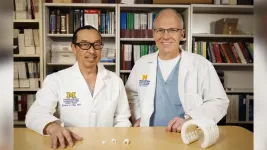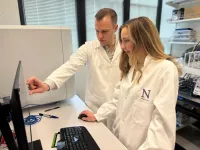(Press-News.org) ANN ARBOR, Mich. – A new clinical trial will allow researchers to study 3D-printed bioresorbable devices aimed at treating children with rare and life-threatening airway condition tracheobronchomalacia.
The trial, launched by Michigan Medicine and Materialise, marks a crucial step towards full Food and Drug Administration (FDA) approval for the innovative devices designed to support the airways of infants with the severest forms of the disease.
Tracheobronchomalacia causes the airway to collapse, making breathing difficult and, in severe cases, can be fatal. Currently, infants with this condition often rely on ventilators to survive.
For more than a decade, University of Michigan Health teams have been obtaining expanded access approval from the FDA on a case-by-case basis to use a first-of-its-kind 3D-printed bioresorbable airway splint to treat these children under emergency and compassionate use. But the groundbreaking treatment is currently accessible to only a limited number of patients.
Now, researchers at Michigan Medicine and 3D printing manufacturing company Materialise are paving the way for broader use of the device through a clinical trial to test its safety and efficacy. The trial opened in January, with the first patients now being enrolled.
“We have established a process that allows us to offer the customized airway splint as a last resort treatment for certain children with no other options but we need more research to make it available on a wider scale,” said trial principal investigator Richard Ohye, M.D., a pediatric heart surgeon at U-M Health C.S. Mott Children’s Hospital, who leads surgical implantation of the device.
Research teams plan to enroll 35 infants in the eight-year study from Mott, as well as four other children’s hospitals across the country, with devices produced by Materialise.
Tracheobronchomalacia, caused when cartilage in the trachea or mainstem bronchi develops abnormally, varies in severity. For most children, symptoms are mild and subsist by age three once the tracheal cartilage has had time to grow stronger.
But Mott otolaryngology surgeon Glenn Green, M.D. said he was frustrated by the lack of options for other children with the severest forms of the condition who faced poor outcomes.
“We needed a revolutionary innovation to give these babies a chance to survive,” Green said.
More than a decade ago, he worked with former U-M professor of biomedical engineering Scott Hollister, Ph.D., to develop a biodegradable scaffolding, which could be designed and manufactured into a tracheal splint customized to the individual patient.
The University of Michigan-developed device is attached to the outer side of the trachea or mainstem bronchi to hold the airway open and prevent collapse and was the first 3D implant made for kids, designed to grow along with the patient, and eventually be safely resorbed into the body.
In 2012, the tracheal splint was used for the first time to save the life of a three-month old with a dire case of tracheobronchomalacia and the successful outcome was outlined in a New England Journal of Medicine report. With assistance from the Michigan Institute for Clinical and Health Research (MICHR), Green and colleagues were able to obtain emergency approval to use the bioresorbable scaffolding through working with the FDA, Institutional Review Board, and hospital administration. It’s since been used in more than 40 children at Mott.
MICHR, Michigan Medicine and Materialise have worked together to obtain approval for the 3D printed bioresorbable devices to be utilized in a clinical trial. The trial is the next step towards FDA approval to treat children with the life-threatening condition.
Throughout the trial, the devices will be printed by Materialise, a large Belgium-based 3D-printing company that has pioneered numerous groundbreaking medical 3D printing applications. With over three decades of experience in developing medical solutions, Materialise operates manufacturing facilities for these bioresorbable splints in Ann Arbor. The company produces 280,000 personalized 3D-printed instruments and implants per year, including 160,000 for the U.S. market.
“The advent of technologies such as 3D printing and advanced visualization techniques has transformed patient-specific care,” said Colleen Wivell, Director of Clinical Engineering at Materialise. “Surgeons increasingly adopt 3D printing as part of their surgical workflow to bring personalized care to patients, improving healthcare and reducing costs overall. We’re so pleased to support this life-saving treatment and look forward to continuing to impact these children and their families.”
Disclosures: Green and Hollister developed the device at the University of Michigan, which licensed the intellectual property to Materialise.
END
Clinical trial opens to study groundbreaking 3D printed device for babies with rare respiratory disease
Michigan Medicine and Materialise launch research study for first-of-its-kind bioresorbable implant intended to help children with severe tracheobronchomalacia
2025-03-06
ELSE PRESS RELEASES FROM THIS DATE:
Effects of shenfu decoction on neutrophil chemotactic function in septic mice
2025-03-06
Background and objectives
Sepsis involves a complex cascade of inflammatory reactions and immune system dysregulation. Neutrophils play a crucial role in modulating the anti-inflammatory response, which is vital for managing sepsis. Impaired chemotaxis of granulocytes can significantly impact the outcome of sepsis. Shenfu Decoction, by tonifying Qi and warming Yang, enhances the propelling function of Qi for promoting the chemotactic function of neutrophils. This study aimed to investigate the effects of Shenfu Decoction on the chemotactic function of neutrophils in septic mice and the underlying ...
ESMT Berlin offers scholarships in executive leadership
2025-03-06
Various full and partial scholarships will be available for three premier programs of ESMT: Bringing Technology to Market, the General Management Seminar, and the Executive Transition Program.
By offering financial support and access to distinguished executive education, ESMT is committed to fostering greater diversity in senior leadership. The initiative empowers professionals from various backgrounds to make a lasting impact in their industries and beyond.
The scholarships are aimed at senior leaders preparing for top executive positions, particularly transitioning from leading corporate divisions into board level as well as accomplished managers holding global responsibilities ...
New WSU study shows how scarcity pricing helps 'cult wineries' drive demand
2025-03-06
PULLMAN, Wash. — When a product is hard to buy, more people want it. A new Washington State University study reveals that wineries producing “cult wines” can boost long-term profits by keeping their prices low, creating excess demand that fuels their brand’s prestige and future revenue.
Economists in WSU’s School of Economic Sciences (SES) analyzed data on cult wines: rare, luxury bottles only available to consumers who secure a spot on a winery’s allocation list or purchase the product via the secondary market. The study, published in the Journal of Economic Behavior & Organization, focused solely on Washington, ...
New discovery and grant to accelerate Strep A vaccine efforts
2025-03-06
Researchers have discovered how antibodies help to protect against contagious bacterial infections caused by Strep A, including strep throat. And the findings are already contributing to efforts to accelerate the development of a Strep A vaccine.
The research, led by Murdoch Children’s Research Institute (MCRI), Monash University and the University of Auckland, using the world’s only human challenge model for Strep A, has uncovered how antibodies respond to strep throat infections.
MCRI Dr ...
Novel enzyme found in gut bacteria could revolutionize prebiotic research
2025-03-06
Carbohydrate chains, or glycans, are complex sugar-like compounds that play important roles in various biological processes and structures in our bodies. Galactosides are a type of glycan found in plants, animals, and microorganisms. For example, galactosides are present in plant cell walls and in certain types of beneficial sugars known as prebiotic oligosaccharides, which support gut health. Many glycans containing galactose are also added to processed foods like juice and powdered milk due to their potential health ...
Study reveals exposure to wildlife and forest walks helps ease symptoms of PTSD in US war veterans
2025-03-06
A new study published in the journal Human-Animal Interactions has revealed that exposure to wildlife and forest walks can help ease the symptoms of Post Traumatic Stress Disorder (PTSD) in US war veterans.
Researchers from UMass Chan Medical School studied 19 veterans with PTSD or PTSD symptoms and found that walking in the forest, assisting with wildlife care in a rehabilitation centre, seeing wildlife in a sanctuary, and bird watching improved psychological symptoms, especially reducing anxiety.
Those that took part in the near four-month study in Massachusetts ...
Urban highways cut opportunities for social relationships, says study
2025-03-06
[Vienna, 06.02.2025]—"In this study, we use the spatial social connections of people within the 50 largest cities in the US to test whether the built environment—in this case, urban highways— is indeed a barrier to social ties, as has long been assumed in urban studies. For the first time, we are also finding quantitatively that this is the case,” explains co-author Sándor Juhász. During his postdoctoral fellowship at the Complexity Science Hub (CSH), Juhász participated in the study.
This ...
Alzheimer’s treatment may lie in the brain’s own cleanup crew
2025-03-06
MEDIA CONTACT: Kristin Samuelson at 847-769-6596 or ksamuelson@northwestern.edu
EMBARGOED FOR RELEASE: 5 a.m. (ET), Thursday, March 6, 2025
Alzheimer’s treatment may lie in the brain’s own cleanup crew
Brain’s immune cells cleared plaques, restored a healthier brain environment in immunized patient brains
Current FDA-approved Alzheimer’s drugs remain controversial, with modest benefits, high cost
First time cutting-edge technique spatial transcriptomics was used on human clinical-trial brains with Alzheimer’s disease
Findings could reshape the future of Alzheimer’s ...
Climate change threatens future of banana export industry
2025-03-06
Climate change is rapidly reducing the ability of banana producers to supply one of our favourite fruits.
New research from the University of Exeter, published in Nature Food, has found it will be economically unsustainable by 2080 for many areas across Latin America and the Caribbean to continue growing bananas for export, because of rising temperatures caused by climate change.
Bananas are a key export crop worth $11 billion (£8.9 billion) annually and are crucial for the economies of many countries. Yet in just over half a century, 60 per cent of the regions currently producing bananas will ...
World’s oldest impact crater found, rewriting Earth’s ancient history
2025-03-06
Curtin University researchers have discovered the world’s oldest known meteorite impact crater, which could significantly redefine our understanding of the origins of life and how our planet was shaped.
The team from Curtin’s School of Earth and Planetary Sciences investigated rock layers in the North Pole Dome — an area of the Pilbara region of Western Australia — and found evidence of a major meteorite impact 3.5 billion years ago.
Study co-lead Professor Tim Johnson, from Curtin University, said the discovery significantly ...
LAST 30 PRESS RELEASES:
Fame itself may be critical factor in shortening singers’ lives
Daily coffee drinking may slow biological ageing of people with major mental illness
New highly efficient material turns motion into power – without toxic lead
The DEVILS in the details: New research reveals how the cosmic landscape impacts the galaxy lifecycle
After nearly 100 years, scientists may have detected dark matter
Gender imbalance hinders equitable environmental governance, say UN scientists
Six University of Tennessee faculty among world’s most highly cited researchers
A type of immune cell could hold a key to preventing scar tissue buildup in wounds
Mountains as water towers: New research highlights warming differences between high and low elevations
University of Tennessee secures $1 million NSF grant to build semiconductor workforce pipeline
Biochar shows powerful potential to build cleaner and more sustainable cities worldwide
UT Health San Antonio leads $4 million study on glucagon hormone’s role in diabetes, obesity
65-year-old framework challenged by modern research
AI tool helps visually impaired users ‘feel’ where objects are in real time
Collaborating minds think alike, processing information in similar ways in a shared task
Routine first trimester ultrasounds lead to earlier detection of fetal anomalies
Royal recognition for university’s dementia work
It’s a bird, it’s a drone, it’s both: AI tech monitors turkey behavior
Bormioli Luigi renews LionGlass deal with Penn State after successful trial run
Are developers prepared to control super-intelligent AI?
A step toward practical photonic quantum neural networks
Study identifies target for disease hyper progression after immunotherapy in kidney cancer
Concordia researchers identify key marker linking coronary artery disease to cognitive decline
HER2-targeted therapy shows promising results in rare bile duct cancers
Metabolic roots of memory loss
Clinical outcomes and in-hospital mortality rate following heart valve replacements at a tertiary-care hospital
Too sick to socialize: How the brain and immune system promote staying in bed
Seal milk more refined than breast milk
Veterans with cardiometabolic conditions face significant risk of dying during extreme heat events
How plants search for nutrients
[Press-News.org] Clinical trial opens to study groundbreaking 3D printed device for babies with rare respiratory diseaseMichigan Medicine and Materialise launch research study for first-of-its-kind bioresorbable implant intended to help children with severe tracheobronchomalacia





